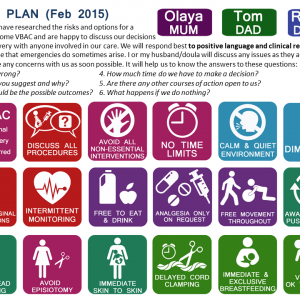The dangers of “winging it” in labour and why every woman needs a birth plan.
Recently, I saw an exchange of comments between two women on Facebook that ended with this post;
“I’m definitely not going in with any birth plans or expectations. Just want the baby out and both of us to be safe and healthy. I don’t care what they have to do really. They are the professionals so I trust they will know what’s right.”
I call this the “close your eyes and hope for the best” approach to labour and birth. Why does childbirth turn so many women into passive onlookers rather than active participants? Why are so many of us willing to hand over autonomy and decisions about our bodies and our babies to others – regardless of how many degrees and qualifications they may have? What is it about giving birth that creates this paralysing fear and willingness to be disempowered?
One of the biggest criticisms I hear about the so-called “natural birth fanatics”, is that these women are in it for “the experience” and that they value their own personal birth experience over the health and well-being of themselves and their baby.
I’ve yet to meet a woman who would ever prioritise her “experience” over the health of her baby. A healthy mother and a healthy baby are a given. An unarguable given.
What I fail to understand is why people think that wanting to avoid unnecessary medical intervention that is well acknowledged to be the catalyst for a lot of obstetric complication is somehow incongruent to safe and healthy birth. Medical intervention is not a rude word. Quite the contrary – when used appropriately, obstetric intervention saves untold numbers of lives around the world every day.
 It’s important to define what we mean by “healthy mother”. If your definition means that she is alive following childbirth, well then yes, I suppose that technically she is “healthy”. However, we cannot ignore the mental health of a new mother, especially when the rates of antenatal and postnatal anxiety, depression and even post-traumatic stress disorder (PTSD) are going through the roof. And it’s not just women. Men, too can suffer severe depression following the birth of their child, particularly if their partner experienced a traumatic birth.
It’s important to define what we mean by “healthy mother”. If your definition means that she is alive following childbirth, well then yes, I suppose that technically she is “healthy”. However, we cannot ignore the mental health of a new mother, especially when the rates of antenatal and postnatal anxiety, depression and even post-traumatic stress disorder (PTSD) are going through the roof. And it’s not just women. Men, too can suffer severe depression following the birth of their child, particularly if their partner experienced a traumatic birth.
Research has shown that as many as one in three women report having experienced a traumatic birth. I don’t know about you, but I find that to be an utterly disturbing statistic. A full third of all women are traumatised by giving birth. What are we doing wrong? Why are so many women having such negative experiences?
What tools can we give women and their partners to help ensure that they have positive and empowering birth experiences?
I believe that education is essential. Fear is often the result of ignorance (and that includes “ignorance is bliss”). Far too many women are over-exposed to fear-laden stories about birth, and don’t get me started on reality television…
Find yourself a great independent childbirth class. I promise you that you’ll learn far more than you ever expected and it will be worth every cent you spend. The birth of our children is probably one of the most significant moments in our entire lives. We should honour it by committing the necessary time to adequately prepare for this monumental life change.
If a woman has chosen to birth in a hospital, then she and her partner should be encouraged to thoroughly research that hospital’s policies and guidelines. If they have hired a private obstetrician, they should find out what their practices are as well. Don’t be afraid to ask the hard questions.
“What is your policy on induction? When and why would you want to induce my labour?”
“Under what circumstances might you want to artificially speed up my labour?”
“What’s your policy regarding electronic foetal monitoring?”
“What’s your policy regarding the third stage of labour?”
“What’s your VBAC policy?”
These are just some of the questions you might want to ask your care provider. It’s your right to ask and your right to know the answers.
Many women decide to write a birth plan – although I prefer the term ‘birth intentions’. As much as we would all like to, none of us can truly plan our births unfortunately!
 I think there is real confusion between expectations and birth plans. A birth plan is not a shopping list of things that you expect will or won’t happen during the labour. A good birth plan is a clear and concise document (or visual representation – but I will get to that in a second) that outlines those aspects of the labour, birth and early postpartum period that are most important to you and your partner, and that you want your care providers to be aware of (and support, ideally). Keep it positive and affirmative. Think; “I/we would like”, “I/we would prefer…” as opposed to; “I/we don’t want” or “I/we will refuse…”
I think there is real confusion between expectations and birth plans. A birth plan is not a shopping list of things that you expect will or won’t happen during the labour. A good birth plan is a clear and concise document (or visual representation – but I will get to that in a second) that outlines those aspects of the labour, birth and early postpartum period that are most important to you and your partner, and that you want your care providers to be aware of (and support, ideally). Keep it positive and affirmative. Think; “I/we would like”, “I/we would prefer…” as opposed to; “I/we don’t want” or “I/we will refuse…”
Your birth plan is a powerful communication tool and it should be shared with your care team well in advance of you arriving at the hospital in the throes of labour. The hospital should have a copy in your medical file – and when you call the hospital to tell them you are in labour and coming in, remind them that they have a copy of your birth plan and to please read it before you arrive. If you have a private obstetrician, you should discuss it with him or her during antenatal appointments (that’s a great way to determine if they are on the same page as you, by the way!).
If you are lucky enough to be cared for by a caseload midwifery team, then you have the amazing advantage of developing your birth plan with your midwives during your pregnancy.
Make sure you have several copies of your birth plan when you come to hospital to have your baby. Every time you meet a new midwife (for example, during a shift change), use the opportunity to introduce yourselves and give her a copy of your birth plan. Don’t just give her a copy and expect her to read it (chances are she won’t have time). Ask her to spend a few minutes with you so you can go through it with her. Most midwives will really welcome this involvement.
 Try and limit your birth plan to a single side sheet of paper. Anything longer than that is likely to be overlooked (or ignored all together). Some midwives jokingly correlate the length of a woman’s birth plan with the amount of obstetric intervention she is likely to experience.
Try and limit your birth plan to a single side sheet of paper. Anything longer than that is likely to be overlooked (or ignored all together). Some midwives jokingly correlate the length of a woman’s birth plan with the amount of obstetric intervention she is likely to experience.
Some women are using visual birth plans now to clearly communicate their intentions. A visual birth plan largely consists of pictograms that represent specific elements of each stage of labour and postpartum. Want to create your own visual birth plan? Check out this link. You should also check out a great new Australian app called My Birth Wishes, which is available on iTunes and Android.
However you decide to communicate your birth intentions, please don’t wing it. Don’t be afraid to have high expectations. Why shouldn’t you want the day you become a mother to be the most amazing day of your life? Play an active – and proactive – role in your labour and birth. Don’t allow yourself to be disempowered. Don’t hand your power over to others. And please mama, have faith in yourself. TRUST YOURSELF. Your body and your baby know how to do this.
Tanya Strusberg is a Lamaze Certified Childbirth Educator (LCCE) and founder of birthwell birthright, an independent childbirth education practice based in Melbourne. In 2015, Tanya was inducted as an FACCE (Fellow of the Academy of Certified Childbirth Educators) in recognition of her significant contribution to childbirth education. Through her internationally-accredited Lamaze Educator Training program, she is very excited to be training a new generation of Australian Lamaze educators.
Last, but absolutely not least, she is also the mum of two beautiful children, her son Liev and daughter Amalia.
